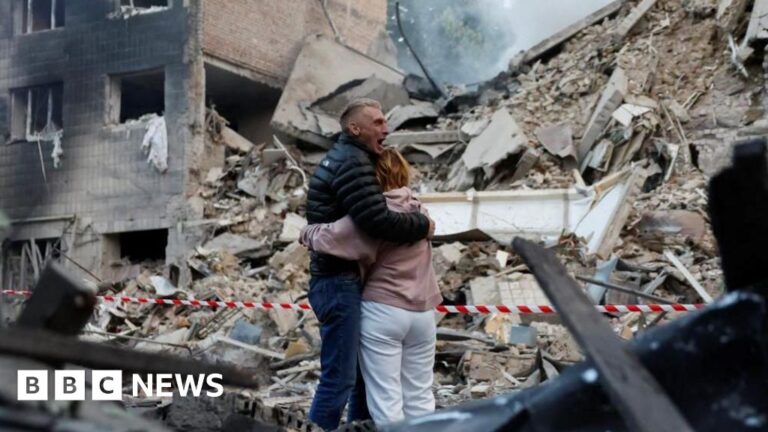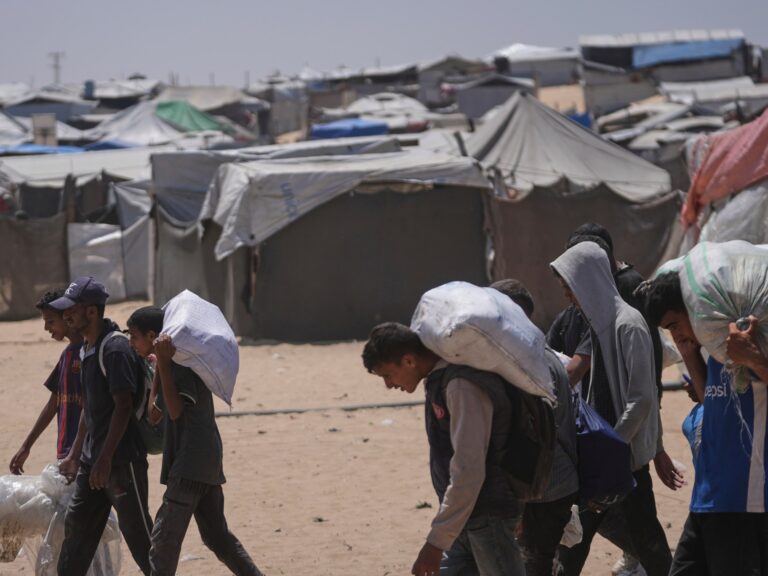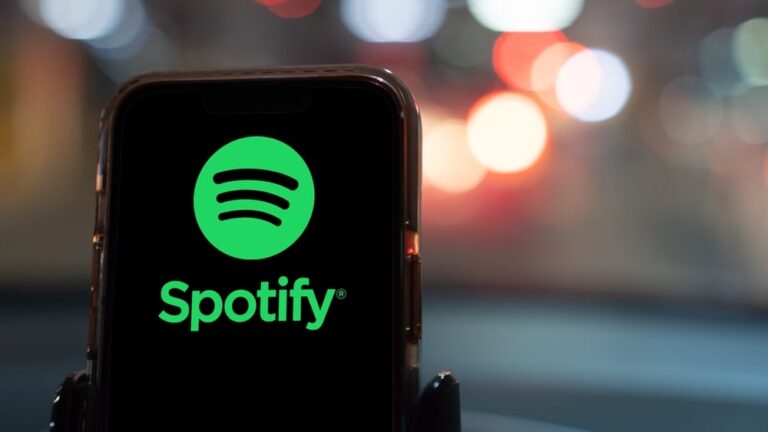
S&P 500 falls on soft retail sales data, fears of further Iran-Israel escalation
S&P 500 drops due to weak retail sales and concerns over Iran-Israel tensions
Recent Attack by Russia in Kyiv Destroys Section of Apartment Building, Resulting in High Casualties
Russia has carried out a mass missile and drone attack on Ukraine’s capital, Kyiv, killing at least 10 people and wounding more than 100 others, officials say.
A drone smashed into an apartment block, destroying dozens of flats and Ukraine’s interior minister said the country had been hit by 440 drones and 32 missiles.
Officials said initially that 15 people had died in the capital, but later revised the number down to 10, with another two fatalities in the southern port city of Odesa.
The attack overnight into Tuesday was among the biggest on the capital since the start of Russia’s full-scale war and President Volodymyr Zelensky said it was “one of the most terrifying strikes”.
Russia’s defence ministry said it had targeted Ukraine’s military-industrial complexes and that all its targets had been hit.
The strikes on Kyiv lasted more than nine hours – sending residents fleeing to underground shelters from before midnight until after sunrise.
Officials said a ballistic missile hit a nine-storey apartment building in one district, with a total of 27 locations in the city coming under fire. An entrance to the building in the southwestern Solomyanskyi district came crashing down and there were concerns the number of casualties could rise.
A 62-year-old US citizen was among those killed, Kyiv’s Mayor Vitali Klitschko said.
 Reuters
ReutersStanding in front of the remains of the building, Klitschko said more than 40 apartments had been destroyed and more people might be trapped under the rubble.
He accused Russia of firing cluster bomblets filled with ball bearings to kill as many people as possible.
“Waking up in utter nightmare: people trapped under rubble and full buildings collapsed,” Ukrainian MP Lesia Vasylenko wrote on X.
Interior Minister Ihor Klymenko said that a variety of buildings had come under Russian attack, including residential, critical infrastructure and educational facilities.
People were still under the rubble by late afternoon and rescue work was going on at two sites, he said. Klymenko explained that initial mistakes made in counting the dead often happened because body parts were wrongly identified.
Loud explosions rocked the city in the early hours of Tuesday, along with the rattle of the machine guns used by mobile Ukrainian air defence units to shoot down drones.
More sirens later in the morning disrupted rescue operations in the city, hampering emergency workers searching the rubble for survivors.
Russia has intensified its air attacks against Ukrainian cities in recent weeks, with a tactic of sending large waves of drones and decoys designed to overwhelm Ukrainian air defences.
Kyiv has launched attacks of its own, as direct talks between the warring sides failed to secure a ceasefire or significant breakthrough.
Russia accused Ukrainian forces of launching a missile strike on a district in occupied Donetsk in eastern Ukraine on Tuesday, and Russia-appointed officials said at least 10 people had been hurt.
A reported 147 Ukrainian drones were shot down over nine Russian regions overnight, Russian news agencies said.
 Reuters
ReutersPresident Zelensky, who has travelled to the G7 summit in Canada, called Russia’s most recent wave of strikes “pure terrorism”.
He accused Russian President Vladimir Putin of carrying out the large-scale strikes “solely because he can afford to continue this war”.
“It is bad when the powerful of this world turn a blind eye to this,” he said, adding: “It is the terrorists who should feel the pain, not normal, peaceful people.”
Drone strikes also hit the southern Ukrainian city of Odesa, killing two people and wounding 10 others, officials said.
Zelensky had been hoping to speak with US President Donald Trump on the sidelines of the G7 summit on Tuesday, but Trump cut short his stay amid the escalating crisis in the Middle East.
The news will come as a blow to Zelensky and his administration, which had been hoping to secure US support at the conference for Ukraine’s strategic and military goals.
Nevertheless, the UK and its allies are expected to announce additional sanctions on Russia on Tuesday in continued efforts to sustain pressure on Moscow over its war in Ukraine.
Finding Clarity in the Chaos: Making Sense of Life at the Pool
Courtesy: Elizabeth Spencer Rosenthal
Sometimes life can feel hectic, and the world around us seems hard to understand. We may feel like we are frantically treading water, trying hard just to remain above the surface.
But I know a place where everything makes sense. And that’s at the pool!
Swim life demands Order, and that can be comforting in an uncertain world.
That’s why there is an Order of Events and Order of Finish. There is order to a relay, too — who leads off, who anchors, and on a medley relay, who swims which stroke, always in the same sequence.
You probably practice at the same time every day, for the same number of hours. You’ll take the same number of strokes from the flags to the wall. You may rush to eat the same protein bar after dryland, and carry the same water bottle, too. Whatever else is going on in your life, when you dive in, all that matters is the next stroke, the next set. The rest gets washed away.
Swimming is methodical. It’s by the numbers. On race day, you’ll step up to the block based on your event number, heat number, and lane number. And If the meet is scheduled to start at 9 a.m., you can be sure that at 8:59, the full heat of competitors will be lined up behind their lanes, waiting for the referee’s whistle to signal that their race is about to begin.
Once the swimmers take their marks, there are rules that dictate virtually every aspect of how each race will be swum. How many yards or meters? Must you be on your back or breast? How many hands must touch the wall on your turn or at the finish?
For those who thrive on order, Meet Warmup — the period that precedes the first race — often gets a bad rap, I would argue unfairly. At first glance, it can seem like an unruly frenzy of frantic water creatures, going every which way in rush hour traffic. But in reality, even in the midst of meet warmup mania, there is a certain order to things. Your team may be assigned to a particular lane at a designated time. And don’t forget: feet-first entry only! Unless of course, the lane is designated for starts. And then you can feel free to dive right in. There really is a method to the madness!
Kids learn from a very young age how to make sense of swim meet mayhem, with a little grid drawn on their arm in Sharpie. Like a cheat sheet, it’s a quick summary of how their day will go. (In addition to writing their key event information, they may also decorate themselves and their friends with cute pictures and fun phrases like, “Eat My Bubbles!”) They quickly form bonds with their teammates, who become their trusted training partners and best lane buddies.
Beauty is always in the eye of the beholder, and for many, including myself, the pool may seem like the most beautiful place in the world. In the legendary Broadway musical, “A Chorus Line,” there is a poignant number called, “At the ballet,” in which the characters sing wistfully about choosing a life at the ballet over the stress and strife in their home lives. “Everything was beautiful at the ballet,” they crooned — a touching tribute to the escape from reality that they found in the beauty of the ballet. And so it is for many who find their solace at the swimming pool.
If show tunes aren’t really your jam, perhaps you can relate more to the iconic TV series Cheers! Like the popular Boston pub (but without the beer), when you come to the pool, you’re instantly part of something bigger, with a broader extended family. As the legendary theme song goes,“You wanna go where everybody knows your name.”
And not just because it’s on your swim cap!
At the pool, your name really may be everywhere: emblazoned in block letters on the side of your head, on the heat sheet, the scoreboard or on your name badge — your teammates, parents and coach may call it loudly as they cheer for you. But that perhaps misses the point — Just as Cheers! was a place where everyone felt understood and appreciated, the pool also provides a sense of familiarity, a community of belonging. Nobody is a stranger at the pool.
Like Billy Joel’s Piano Man, perhaps you’ve come to the pool “to forget about life for a while.” But when the day is done and the final warm down has been swum (and surely you swam all of it!), you’ll pack up your gear and head out into the world, leaving behind the comfortable confines of the pool. Back to real life and all of its regular responsibilities, perhaps to eat, sleep or talk to a friend. But don’t worry, be happy— because in about 12 hours, you’ll wake up, grab your bag, and head back to the pool to do it all again.
ABOUT ELIZABETH SPENCER ROSENTHAL

 Elizabeth Spencer Rosenthal is a wife and mother of 3 from Miami. She is a passionate swim mom, volunteer and meet official, with a professional background in marketing and public relations. She holds a degree in Public Communication from American University, and loves finding a story to tell.
Elizabeth Spencer Rosenthal is a wife and mother of 3 from Miami. She is a passionate swim mom, volunteer and meet official, with a professional background in marketing and public relations. She holds a degree in Public Communication from American University, and loves finding a story to tell.
Amazon reveals Prime Day 2025 specifics
- Prime Day will return from July 8-11 in 2025. This is the first time the company has run the promotion for four days. This year marks the 10th anniversary of Prime Day.
On July 15, 2015, Amazon launched an experiment. Would a flashy sale, in the retail desert of summer, turn people’s attentions away from outdoor activities and captivate them in a way akin to Black Friday? The company called that event Prime Day—and the results speak for themselves.
Now, as the 10th anniversary of that retail event comes up, Amazon is ramping things up even further. Prime Day 2025 will last an unprecedented four days, Amazon announced Tuesday. And it’s offering a slew of deals long before things get started.
Prime Day 2025 will take place from July 8 through July 11. The offers for Prime members, though, start a week earlier. Amazon will cut prices on a number of its own brands by 30% on July 1, dropping school supplies and “household essentials” to as low as $3 and dresses to $12.
The big draw for Prime members, though, might be the offer that will run from July 3 to 6. During that time, Prime members can get $1 off per gallon for up to $35 gallons at over 7,500 bp, Amoco and select ampm locations.
Other offers for Prime members include:
- Save $10 on a Grubhub+ delivery order over $20 with the code “PRIME10” now through July 7
- Get a $200 Amazon Gift Card instantly upon approval for Prime Visa (through July 14) or an $80 Amazon Gift Card instantly upon approval for Prime Store Card (from July 2–11).
- Rent a car with Avis and get up to 30% off base rates and 10% back in an Amazon.com gift card.
Beyond the usual Prime accounts, Amazon also announced an enhanced membership for people 18-24. Prime for Young Adults, as it’s called, will cost $69 per year (or $7.49 per month) and will include 5% cash back savings on popular categories (and 10% cash back during Prime Day) in addition to all of the usual Prime perks. New members can get 6 months for free.
The Mechanics of Missile Defense: Understanding its Functionality and Limitations
Once a
The target,
Since Friday, Iran has been firing a barrage of ballistic missiles at targets across Israel, a reprisal for a devastating surprise attack the Israeli government launched against Iranian nuclear and military sites.
The world’s most advanced missile defense systems, deployed by Israel and the United States, stopped some of the missiles — but not all of them. The strikes, like the Israeli ones on Iran, have killed civilians, officials in both countries say.
Here’s why stopping a ballistic missile attack is so difficult.
Ballistic missiles like the ones being fired by Iran escape the atmosphere and accelerate to great speeds as they fall back down to Earth. It takes only about 12 minutes for Iran’s missiles to reach Israel, analysts estimate.There is far less time to make critical decisions about how to stop them.
Within seconds,
A defensive missile called
That’s all hard enough with one missile. But Iran has been firing
Radars can only track so many targets at once, and launchers, once emptied, may need a half hour or more to reload.
Beyond that, if they are concerned about future attacks, targeted countries may also need to make a critical split-second decision to
Israel’s best-known defense system, the Iron Dome, was built to stop short-range rockets, and is too slow and limited when it comes to ballistic missiles. For that, Israel relies on several more advanced layers of defense designed to counter ballistic missiles at different stages of flight.
The most advanced systems, long-range interceptors like the Arrow 3, operate in space, where ballistic missiles like those Iran fired spend most of their time. They are the first chance to stop a missile, but high above the atmosphere, there is no room for error.
Both an
The interceptor seeks
That’s because missiles like Iran’s latest are only about
If that weren’t hard enough, some ballistic missiles carry
It’s unclear how often interceptions above the atmosphere actually work. Governments tend to avoid disclosing specific interception rates, and they have every reason to present a positive picture, even when interceptions fail. So do the companies that manufacture the pricey systems.
When combined with U.S. antimissile systems in the region, Israel currently has the most layers of missile defense in the world. If outer-layer defenses fail to stop a missile, shorter-range systems that intercept missiles closer to the ground may have another chance.
But time runs out quickly. The closer a ballistic missile gets, the more dangerous it becomes. And even if a lower-altitude intercept is successful, the resulting debris can still be deadly.
If a missile succeeds in re-entering the atmosphere, often less than a minute remains before it strikes.
Defenses that work
As the missile nears the ground,
An attacker can draw on a variety of tactics. To distract the enemy, it can fire a volley of cheaper
Last year, too, Iran fired big barrages of missiles at Israel, but left limited damage. When Israel and Iran clashed last year, they fought in short and contained bursts that usually ended within hours, and both sides looked for off-ramps that allowed tensions to ebb.
But this time both countries have little incentive to stop and no obvious route to outright victory.
Over the course of a protracted conflict, it could become a question of which side runs out of missiles first.
The Importance of Appreciating Both Together
I used to think “home” was a dirty word. Out there — on the road — was where life happened, full of exciting adventures, fascinating people, and endless possibilities. No dreary commutes, 30-minute lunch breaks, mind-numbing meetings, or endless lists of to-dos squeezed into a rushed weekend.
Why would anyone want to be home, the place where routine seemed to sap your will to exist? It baffled me.
My first trip overseas — a vacation to Costa Rica — made me fall in love with travel. For all the reasons mentioned above, I realized why “vacations” were so romanticized in work culture. There was a freedom to them that stood in stark contrast to the daily corporate grind.
So, when I finally quit my job, I set off on an adventure to experience all the world had to offer for as long as I could make my money last.
I mean, who could possibly tire of life on the road?
Well, me.
Eventually, I did tire of being a full-time nomad. I craved a stable group of friends, regular workouts, a bar that knew my name, a kitchen to cook in, and my own bed.
Suddenly, I realized that “home” wasn’t a dirty word. It just felt that way to a young, restless soul for whom adulthood felt eons away.
I had come to understand what someone who is just setting out with romantic notions about travel couldn’t: You can burn out. On my first trip abroad, after 18 months, I hit the wall and decided to cut my trip short. Then, years later, in 2013, I decided that being a nomad was no longer the life for me and decided to stop traveling full-time.
It was time to grow up, I said. Time to stay put and move on from nomad to… whatever came next.
But the allure of the road — and the business of working in travel — pulled me back constantly.
As the years went by, I lived between two worlds: one in which I am traveling, longing for home, and another in which I am home, longing to head out again.
There were moments where I longed for a clone so I could live in both and satisfy my dual desires.
After all, you can’t — and shouldn’t — live solely in one forever.
Because travel and home are complementary forces, yin and yang. Without one, you can’t appreciate the other.
All travelers hit a wall, that moment when they look around and go, “I’m ready to stay in one place.” When and why that happens is a product of many factors, but I have yet to meet a traveler who doesn’t have that experience. When I started traveling in my twenties, it took me years to feel that. But now, a couple of decades older, it happens after just a month.
To handle life, the brain creates mental shortcuts to help it process information. It’s why we tend to drive the same route to work every day — it’s just easier, and it’s why you feel like “you can do it in your sleep.” Because if your brain had to figure out a new route to work every day, it would tire itself out. These routines let us put a lot of life on autopilot, so we have energy for work, people, emotions, thoughts, etc.
But when you travel, you are relearning life skills every day. You have no mental shortcuts. It takes a lot of mental energy to figure out your way in the world anew each day, to repack your bag, say good-bye to the person you met yesterday, and head out and try again to navigate unfamiliar lands, languages, and people as if you had never done so before.
It tires you out.
Whereas a vacation is a temporary break from life, long-term travel is different. When you travel long-term (or are on the move frequently), there is no break. You’re constantly trying to figure things out and also constantly breaking your routine. Your travel battery drains.
Yet in the same way the travel battery needs to be recharged, our “home” battery does too.
While some people can follow the same routine their entire lives, most of us can’t. We find it boring. We need a break. After a while in one place, we yearn to break up the monotony of our daily routine. Work, commutes, errands… day in, day out, like ants marching on and on.
So we go travel again. We have an adventure, meet new people, try new food, and have new experiences. Maybe be learn, grow, and expand who we are as a person. Maybe we’re away for a week or two or we take a month off. Or we start working remotely and spend months away. But eventually our battery drains: we get tired, and then we head home again.
And the cycle repeats.
Growing older has made me believe that we can never fully appreciate home or travel without the other. My first years on the road would never have been so amazing if I weren’t trying to break free from a quarter-century of routine. Likewise, my bed never would have felt so good had I not spent so many years on the move, changing rooms, and having erratic sleep. Nor would I have enjoyed the relief that routine brings had I not spent so many days trying to navigate the stresses of the world for so long.
The joy of one is amplified by the other.
Travel and home are two sides to the same coin. I appreciate each more now than when I was younger, because I get to experience both on my own terms. I’m not trying to run away from either or go to an extreme anymore. I simply follow their ebb and flow and let the battery of life dictate when one or the other happens.
And I think that is a wisdom that only comes with age — and experience.
How to Travel the World on $75 a Day


My New York Times best-selling book to travel will teach you how to master the art of travel so that you’ll get off save money, always find deals, and have a deeper travel experience. It’s your A to Z planning guide that the BBC called the “bible for budget travelers.”
Book Your Trip: Logistical Tips and Tricks
Book Your Flight
Find a cheap flight by using Skyscanner. It’s my favorite search engine because it searches websites and airlines around the globe so you always know no stone is being left unturned.
Book Your Accommodation
You can book your hostel with Hostelworld. If you want to stay somewhere other than a hostel, use Booking.com as it consistently returns the cheapest rates for guesthouses and hotels.
Don’t Forget Travel Insurance
Travel insurance will protect you against illness, injury, theft, and cancellations. It’s comprehensive protection in case anything goes wrong. I never go on a trip without it as I’ve had to use it many times in the past. My favorite companies that offer the best service and value are:
Want to Travel for Free?
Travel credit cards allow you to earn points that can be redeemed for free flights and accommodation — all without any extra spending. Check out my guide to picking the right card and my current favorites to get started and see the latest best deals.
Need a Rental Car?
Discover Cars is a budget-friendly international car rental website. No matter where you’re headed, they’ll be able to find the best — and cheapest — rental for your trip!
Need Help Finding Activities for Your Trip?
Get Your Guide is a huge online marketplace where you can find cool walking tours, fun excursions, skip-the-line tickets, private guides, and more.
Ready to Book Your Trip?
Check out my resource page for the best companies to use when you travel. I list all the ones I use when I travel. They are the best in class and you can’t go wrong using them on your trip.
The Progression of Sustainable Agriculture through Green Hydrogen
Agriculture and construction are major contributors to global greenhouse gas emissions, together accounting for 37% of the total. Agriculture alone contributes 12%, and it faces the dual challenge of meeting growing food demands while reducing its environmental footprint. This article explores how green hydrogen can help foster sustainable agricultural practices.
Here are some of its most important applications.
Do you like what you see? Download the PDF here.
Examples of sustainable agriculture with green hydrogen
While renewable energy sources can meet most of a farm’s energy needs, certain operations—such as running heavy machinery or heating systems—require an additional solution. Here, green hydrogen emerges as a critical complement to renewable energy, enabling sustainable development. Below are examples of how green hydrogen is driving more sustainable agricultural practices.
Emission-free agricultural machinery
Tractors, harvesters, and other heavy machinery traditionally rely on fossil fuels like diesel because the energy density of current electric batteries is not sufficient to power such equipment for extended periods. Green hydrogen offers an alternative, enabling emissions-free operation of agricultural machinery.
There are two ways to utilize green hydrogen in heavy machinery:
- Direct combustion: Using green hydrogen as a substitute for natural gas in combustion engines.
- Fuel Cells: Employing hydrogen fuel cells to convert hydrogen into electricity, which then powers electric motors.
For example, researchers at the Vienna University of Technology (TU Wien) have developed a hydrogen-powered tractor prototype that uses a fuel cell to charge a 14 kWh battery. This innovation eliminates carbon emissions, producing only water vapor as a byproduct. Major manufacturers are also exploring similar technologies to transition agricultural machinery away from fossil fuels.
More sustainable fertilizers
The Haber-Bosch process, which synthesizes ammonia by extracting nitrogen from the air, revolutionized intensive agriculture by enabling large-scale fertilizer production. However, this energy-intensive process currently depends on fossil fuels and emits significant amounts of CO₂.
Integrating green hydrogen into the Haber-Bosch process can substantially lower these emissions. Replacing conventional hydrogen (derived from natural gas) with green hydrogen (produced via electrolysis powered by renewable energy) minimizes the environmental impact of fertilizers.
At the same time, as the agricultural sector moves toward reducing chemical fertilizer use, organic fertilizers made from biodegradable materials offer a promising alternative. These options help cut dependency on synthetic products with a high carbon footprint.
Notably, one of the world’s largest potato chip manufacturers recently partnered with a fertilizer producer to source fertilizers made with green hydrogen. This initiative will greatly reduce CO₂ emissions in potato farming, promoting a more sustainable supply chain.
Heating and irrigation systems
Maintaining optimal temperatures is essential for greenhouses and livestock facilities, especially during winter. Green hydrogen can replace diesel or natural gas to provide heat in situations where solar or wind energy is insufficient. It can also power irrigation systems and pumps for well water.
In Ontario, Canada, a pilot project is using green hydrogen derived from wind energy to heat greenhouses. This approach enables agricultural production during harsh winters without relying on fossil fuels.
The era of energy self-sufficiency
Green hydrogen, produced through renewable energy and water electrolysis, has the potential to make farms more sustainable and self-reliant. Installing small electrolyzers on-site, along with solar panels and wind turbines, would allow farms to meet their energy needs independently, reducing reliance on external power grids.
If you’re interested in learning about other renewable energy sources, such as wave energy or blue energy, which complement established solutions like wind and solar power, subscribe to our newsletter at the bottom of this page.
Sources:
Israeli forces shoot multiple people at Gaza aid site as death toll rises | Israel-Palestine conflict Updates
Israeli soldiers have killed dozens of Palestinians and wounded hundreds as they sought aid in Gaza, according to Palestinian officials.
The soldiers fired at the crowds on Tuesday morning as they gathered along the main eastern road in the southern city of Khan Younis. It was the latest in a string of killings since the Israel- and United States-backed Gaza Humanitarian Foundation (GHF) launched operations to distribute food in the enclave three weeks ago.
The Palestinian Ministry of Health reported that at least 51 civilians were killed. However, the death toll is expected to rise as many of the injured are in a critical condition, according to medics at Nasser Hospital, where the casualties were being treated.
Gaza Civil Defence spokesman Mahmud Bassal added that more than 200 people were injured although reports concerning the number of casualties varied.
“Israeli drones fired at the citizens. Some minutes later, Israeli tanks fired several shells at the citizens, which led to a large number of martyrs and wounded,” the spokesman said, noting that the crowd had assembled in the hope of receiving flour.
Israel did not immediately comment on the incident.
‘Shredded to pieces’
Survivors described horrific scenes.
“Dozens of civilians, including children, were killed, and no one could help or save lives,” survivor Saeed Abu Liba, 38, told Al Jazeera.
Yousef Nofal, who called the event a “massacre”, said he saw many people lying motionless and bleeding on the ground. The soldiers continued to fire on people as they fled, he said.
“I survived by a miracle,” said Mohammed Abu Qeshfa, who mentioned both heavy gunfire and tank shelling.
Al Jazeera’s correspondent Tareq Abu Azzoum, reporting from Deir el-Balal in central Gaza, quoted medical sources at Nasser Hospital as saying many victims were “unidentifiable” because they had been “shredded to pieces” in the attack.
The incident on Tuesday is the latest in a string of killings around GHF food distribution centres.
The private organisation began distributing aid at the end of May after Israel partially lifted an almost three-month blockade of food and other essential items that has put Gaza’s 2.3 million people at risk of famine.
The United Nations and other major humanitarian groups have refused to work with the GHF, saying it cannot meet the level of need in Gaza and it breaks humanitarian principles by giving Israel control over aid access.
After previous shootings, which have been a near-daily occurrence since the aid centres opened, the military has said its soldiers had fired warning shots at what it called suspects approaching their positions although it did not say whether those shots struck anyone.
The death toll of more than 50 people made Tuesday the deadliest day around the GHF sites so far. Previously, that record was set on Monday, when 38 people were killed, mostly in the Rafah area south of Khan Younis.
Reports indicated more than 300 people have been killed and more than 2,000 wounded while trying to collect aid from the GHF.
UN High Commissioner for Human Rights Volker Turk has hit out at Israel over the killings of Palestinians near the aid delivery points.
“I urge immediate, impartial investigations into deadly attacks on desperate civilians to reach food distribution centres,” he said on Monday.
Streams de musique en français sur Spotify augmentent de 192% depuis 2019
French-language music consumption on Spotify has jumped 192% since 2019, driven by audiences far beyond traditional Francophone markets.
That’s according to Spotify’s latest Francophone Report for June 2025, which revealed that more than 123 million users consumed French content in 2024, including over 100 million listeners based outside France, Quebec, Belgium, and other historically French-speaking regions.
Monthly listening of French-language music now totals more than 64 million hours worldwide, according to the report.
Spotify first published its Francophone Report in October 2024. At the time, the streaming giant said streams of French-language tracks increased by 94% from 2019 to July 2024.
Gustav Gyllenhammar, Vice President Markets and Subscriptions at Spotify, said: “We’re seeing listenership for Francophone content explode in markets across Asia, Africa and Latin America, a phenomenal proof point for Spotify’s ability to help artists and creators find their audience, no matter where they are.”
The 192% increase came even as Spotify has faced increasing competition from Apple Music, Amazon Music, and YouTube Music.
“We’re seeing listenership for Francophone content explode in markets across Asia, Africa and Latin America, a phenomenal proof point for Spotify’s ability to help artists and creators find their audience, no matter where they are.”
Gustav Gyllenhammar, Spotify
The report also revealed that playlist additions of Francophone titles increased 26% between 2023 and 2024 alone, with the growth rate averaging 25% annually since 2020.
Peak listening occurs at 5 pm local time across markets, while November 29 marked the highest single-day consumption of French content outside France in 2024.
The growth in Francophone content consumption was led by artists including Belgian singer and rapper Stromae, Congolese singer GIMS, Canadian singer-songwriter Patrick Watson, Algerian singer and rapper Soolking, French-Malian singer-songwriter Aya Nakamura, and French artists Jul, Indila, Tayc, Gazo, and PNL.
Watson’s Je te laisserai des mots remains the most-listened to Francophone title on Spotify globally, accumulating over 6.6 million streams in 2024.
African Francophone artists are also gaining recognition, with acts like Magic System, Vieux Farka Touré, Amadou & Mariam, Sidiki Diabaté and Jeune Lion finding new audiences.
The report also showed Quebec representing a significant driver of French content export, with 49% of the province’s Spotify users regularly consuming French-language media.
In addition to music, Spotify has also seen growth in French podcasts and audiobooks consumption. French-language podcast listening has surged 1,888% since 2019, with non-French speakers averaging more than four hours monthly of French audio content.
“It’s incredible to see the power of our platform connecting over 100 million fans globally with Francophone content. This is more than just a musical trend, it’s a testament to our ability to deliver creativity and fuel discoverability across the globe.”
Gustav Gyllenhammar, Spotify
Spotify launched French audiobooks in October 2024, and they have since attracted “several hundred thousand” listeners globally.
Gyllenhammar added: “It’s incredible to see the power of our platform connecting over 100 million fans globally with Francophone content. This is more than just a musical trend, it’s a testament to our ability to deliver creativity and fuel discoverability across the globe.”
“Spotify offers audio creators from all walks of life, from Québec to West Africa, a global stage – and we’ll continue to support them in growing their audience on our platform.”
Earlier this month, a Spotify spokesperson reportedly confirmed to Billboard that individual Premium prices in France rose 9.2% to €12.14 ($14.03 at the current exchange rate) from €11.12 ($12.85).
Spotify France’s website already reflected the change. France last saw a price rise from Spotify in May 2024 following the country’s implementation of a streaming tax requiring platforms with annual revenue exceeding €20 million ($23 million) to pay an additional 1.2% music streaming tax.
France is the world’s sixth-largest music market, according to IFPI’s 2025 Global Music Report.
Music Business Worldwide
Experts are skeptical of the claim that a gold phone can be manufactured in the United States.
Business reporter, BBC News
North America technology correspondent
 Trump Mobile
Trump MobileExperts have cast doubt on the Trump Organization’s claim that its proposed smartphone can be made from all-American components.
One industry analyst told the BBC it would be “virtually impossible” for the gold-coloured handset – which will retail at $499 (£367.50) – to be built in the United States.
Questions have also been raised about the ethics of what is the latest in a series of attempts to cash in on President Donald Trump’s name.
“It’s unbelievable that the Trump family has created yet another way for President Trump to personally profit while in office,” said Meghan Faulkner, communications director for Citizens for Responsibility and Ethics in Washington.
The phone will also come alongside a mobile phone service with a monthly fee of $47.45.
The figure is a reference to Trump serving as the country’s 47th and 45th president.
Trump has said he has put his business interests in a trust, which is managed by his children. The White House has maintained he acts in the interests of all Americans.
But Ms Faulkner said the latest venture raised familiar issues, including whether the new business will win customers from people hoping to influence Trump and how the president will craft policies and regulation for an industry in which his family now has a stake.
Made in America?
The Trump family has not said which company would manufacture its phone in the United States.
“Eventually, all the phones can be built in the United States of America,” Eric Trump said on “The Benny Show” podcast on Monday – suggesting the phones released in August may not entirely be manufactured within the country.
Technology experts have questioned what the Trump Organization’s “built in the United States” claim about its handsets means and argued it is probably not currently possible to manufacture smartphones from scratch in the US.
“They don’t even have a working prototype. It’s extremely unlikely,” said Prof Tinglong Dai, who teaches operations management at Johns Hopkins’ Carey Business School.
“You would have to have a miracle. You would need to have economies of scale. You would need to have sustainable demand for this kind of product,” Prof Dai added.
The decision comes as Trump tries to pressure Apple chief executive Tim Cook to manufacture iPhones sold to American buyers in the US.
Last month, the president threatened to place a 25% import tax “at least” on iPhones not manufactured in America.
Analyst Leo Gebbie of CCS Insight noted that the US currently “simply does not have the high-tech supply chain” required for smartphone assembly, especially not in time to be released in August, as the Trump Organization has said.
“However, it’s possible that the device could be assembled in the US with parts imported from abroad. This might be the most likely outcome that lets the T1 claim American sovereignty,” Mr Gebbie said.
The announcement was light on details, including the name of the business partner that will run the service and is licensing the name.
The Trump Organization did not immediately respond to questions from the BBC about its business partner, criticisms around potential ethics issues and a request for details of its “built in the United States” claim.
In announcing its plans, it said “hard-working Americans deserve a wireless service that’s affordable, reflects their values, and delivers reliable quality they can count on”.
It pitched a policy of “discounted” international calls to families with members serving outside the US in the military.
The announcement said the mobile service would have customer support staff based in the US to answer questions, as well as the gold-coloured phone, which is currently available for pre-order.
Trump’s net worth has more than doubled
The deal is an extension of a business strategy that Trump embraced long before his presidency, striking deals to sell his name to hoteliers and golf course operators in exchange for fees and royalties.
But the opportunities to profit from his brand have expanded since he entered politics a decade ago.
In his most recent financial disclosure, Trump reported making more than $600m last year, including millions from items such as Trump-branded bibles, watches sneakers and fragrances.
Forbes in March estimated his net worth was $5.1bn, more than double what it was a year earlier.
It said the surge was due in part to the president’s “diehard following”, which is credited with helping to prop up the value of Trump’s social media company that runs the Truth Social platform, which accounted for roughly half his wealth last year.
The idea of a Trump-related smartphone has received mixed reaction online with some people ready to buy it and others mocking the concept.
“Where do I have to wait in line to buy the new Trump phone?” one X user wrote.
Others have mocked the design, and poked fun at the phone habits of the man it’s named after, asking if texts on the new handset will all be in capital letters.
The mobile phone market in the US is currently dominated by three major players: AT&T, Verizon and T-Mobile, which all offer phone service starting at less than $40 a month.
There are also a growing number of smaller firms paying to use those networks to target niche groups of potential customers, by offering lower prices or tailored plans.
The largest of those companies, which are known as mobile virtual network providers, have less than 10 million subscribers, according to a 2024 report by the Federal Communications Commission.
Mint Mobile, which was backed by Hollywood star Ryan Reynolds, was sold to T-Mobile for $1.35bn in 2023. At the time, one analyst estimated the service had roughly two to three million subscribers.
The actor had a 25% stake in the business, giving him a potential payout of about $300m.











